Second in our Edible Chemistry Set** series is an experiment that involves a colloid, enzymes and molecular bonds.
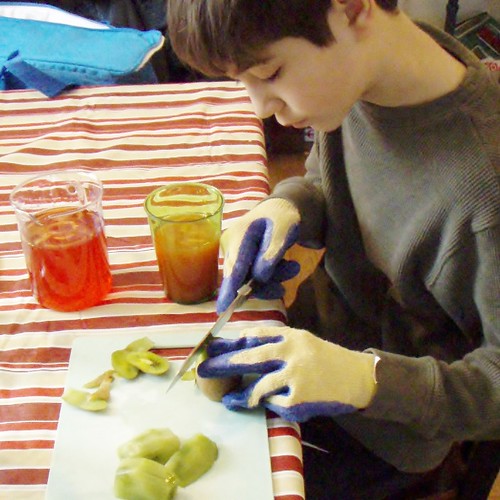 Ingredients:
Ingredients: 2 packets of unflavored gelatin
2 cups of fruit juice (using our super-cool measuring cup , we found that this was slightly more than the volume of twenty thousand grains of rice)
, we found that this was slightly more than the volume of twenty thousand grains of rice)
2 fresh, soft kiwis* (or one fresh, juicy pineapple*)
Place both glasses in the refrigerator and wait for at least an hour. Remove.
Eat the first glass! Drink the second one!
What happened:
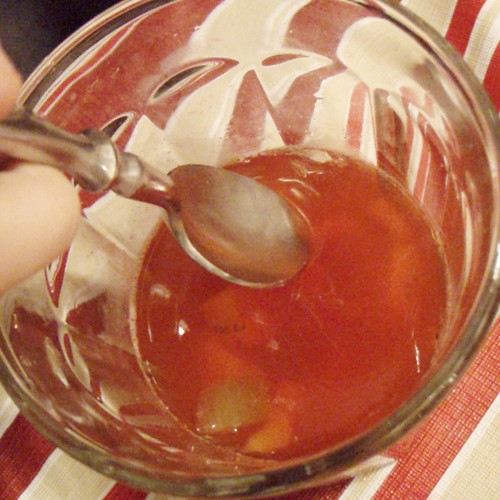 Gelatin is a colloid. In a colloid, two different substances are mixed together, and one is finely dispersed (scattered) throughout the other. A gel is formed when these particles link together into a web using molecular bonds: the molecules hook together into a structure that behaves like a solid, even though it is mostly liquid. In gelatin, these bonds are created by a protein called collagen that we get from meat by-products like bones and skin. (Pectin and agar are vegetable versions of the same process, but they create a starch structure instead of a protein structure.)
Gelatin is a colloid. In a colloid, two different substances are mixed together, and one is finely dispersed (scattered) throughout the other. A gel is formed when these particles link together into a web using molecular bonds: the molecules hook together into a structure that behaves like a solid, even though it is mostly liquid. In gelatin, these bonds are created by a protein called collagen that we get from meat by-products like bones and skin. (Pectin and agar are vegetable versions of the same process, but they create a starch structure instead of a protein structure.)
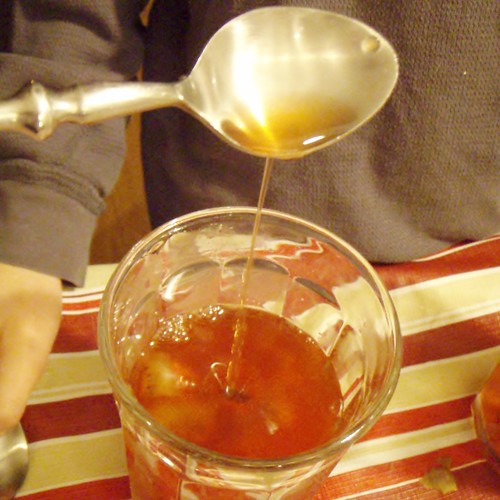 Most fruit contains small amounts of protein-digesting enzymes called proteases, but they are plentiful in certain fruits, for instance, kiwi, pineapple, papayas, mangoes and figs. These enzymes eat through the molecular bonds in the collagen that hold the gelatin in a solid - so if you add any of these fresh fruits to gelatin, it will probably dissolve.* Meat tenderizer, a protease powder you can find in your spice aisle, is usually made from the papain enzymes found in papayas, or the bromelain enzyme from pineapples.
Most fruit contains small amounts of protein-digesting enzymes called proteases, but they are plentiful in certain fruits, for instance, kiwi, pineapple, papayas, mangoes and figs. These enzymes eat through the molecular bonds in the collagen that hold the gelatin in a solid - so if you add any of these fresh fruits to gelatin, it will probably dissolve.* Meat tenderizer, a protease powder you can find in your spice aisle, is usually made from the papain enzymes found in papayas, or the bromelain enzyme from pineapples.
These enzymes will denature if exposed to heat, so cooking the kiwi fruit deactivated its digestive powers. This is one reason why fresh fruit is preferable to canned - canned foods are cooked at a high temperature to kill off pathogens, but that also destroys the enzymes. If you eat fresh fruit, the enzymes can work with your body to break down protein - so it stands to reason that fresh fruit might make your digestive system more efficient!
2 fresh, soft kiwis* (or one fresh, juicy pineapple*)
Equipment:
A knife and cutting board
1 microwave-safe bowl
2 clear containers that hold more than 1 cup each (you can use large drinking glasses)
Directions:
Make fruit juice flavored gelatin: – pour ½ cup fruit juice into a large bowl. Sprinkle 1 packet unflavored gelatin over the juice and allow it to “bloom” or dissolve slightly. After 5 minutes, add half the remaining juice and mix thoroughly. Place in the microwave, microwave on high for 40 seconds, check to see if all the gelatin is dissolved. If not, stir, and continue to microwave in 40-second increments and stir until you can’t see gelatin granules any more. Add the remaining juice and stir thoroughly.
Place the bowl in the refrigerator and allow to cool for 10 minutes.
Divide the gelatin mixture evenly into your two clear glasses.
 Cut the kiwi: slice off the stem and blossom end. Using this as your "flat" side, cut around the sides of the kiwi to remove the skin. Cut into halves, strips, and then cubes. Mix one kiwi's worth of cubes into one glass of fruit gelatin.
Cut the kiwi: slice off the stem and blossom end. Using this as your "flat" side, cut around the sides of the kiwi to remove the skin. Cut into halves, strips, and then cubes. Mix one kiwi's worth of cubes into one glass of fruit gelatin.
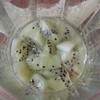 Microwave the remaining kiwi or pineapple in 30-second increments until the juice is boiling and it is soft and thoroughly cooked. Allow to cool completely. Mix the cooked kiwi into the second glass of gelatin.
Microwave the remaining kiwi or pineapple in 30-second increments until the juice is boiling and it is soft and thoroughly cooked. Allow to cool completely. Mix the cooked kiwi into the second glass of gelatin.
1 microwave-safe bowl
2 clear containers that hold more than 1 cup each (you can use large drinking glasses)
Directions:
Make fruit juice flavored gelatin: – pour ½ cup fruit juice into a large bowl. Sprinkle 1 packet unflavored gelatin over the juice and allow it to “bloom” or dissolve slightly. After 5 minutes, add half the remaining juice and mix thoroughly. Place in the microwave, microwave on high for 40 seconds, check to see if all the gelatin is dissolved. If not, stir, and continue to microwave in 40-second increments and stir until you can’t see gelatin granules any more. Add the remaining juice and stir thoroughly.
Place the bowl in the refrigerator and allow to cool for 10 minutes.
Divide the gelatin mixture evenly into your two clear glasses.
 Cut the kiwi: slice off the stem and blossom end. Using this as your "flat" side, cut around the sides of the kiwi to remove the skin. Cut into halves, strips, and then cubes. Mix one kiwi's worth of cubes into one glass of fruit gelatin.
Cut the kiwi: slice off the stem and blossom end. Using this as your "flat" side, cut around the sides of the kiwi to remove the skin. Cut into halves, strips, and then cubes. Mix one kiwi's worth of cubes into one glass of fruit gelatin. Microwave the remaining kiwi or pineapple in 30-second increments until the juice is boiling and it is soft and thoroughly cooked. Allow to cool completely. Mix the cooked kiwi into the second glass of gelatin.
Microwave the remaining kiwi or pineapple in 30-second increments until the juice is boiling and it is soft and thoroughly cooked. Allow to cool completely. Mix the cooked kiwi into the second glass of gelatin.Place both glasses in the refrigerator and wait for at least an hour. Remove.
What happened:
 Gelatin is a colloid. In a colloid, two different substances are mixed together, and one is finely dispersed (scattered) throughout the other. A gel is formed when these particles link together into a web using molecular bonds: the molecules hook together into a structure that behaves like a solid, even though it is mostly liquid. In gelatin, these bonds are created by a protein called collagen that we get from meat by-products like bones and skin. (Pectin and agar are vegetable versions of the same process, but they create a starch structure instead of a protein structure.)
Gelatin is a colloid. In a colloid, two different substances are mixed together, and one is finely dispersed (scattered) throughout the other. A gel is formed when these particles link together into a web using molecular bonds: the molecules hook together into a structure that behaves like a solid, even though it is mostly liquid. In gelatin, these bonds are created by a protein called collagen that we get from meat by-products like bones and skin. (Pectin and agar are vegetable versions of the same process, but they create a starch structure instead of a protein structure.) Most fruit contains small amounts of protein-digesting enzymes called proteases, but they are plentiful in certain fruits, for instance, kiwi, pineapple, papayas, mangoes and figs. These enzymes eat through the molecular bonds in the collagen that hold the gelatin in a solid - so if you add any of these fresh fruits to gelatin, it will probably dissolve.* Meat tenderizer, a protease powder you can find in your spice aisle, is usually made from the papain enzymes found in papayas, or the bromelain enzyme from pineapples.
Most fruit contains small amounts of protein-digesting enzymes called proteases, but they are plentiful in certain fruits, for instance, kiwi, pineapple, papayas, mangoes and figs. These enzymes eat through the molecular bonds in the collagen that hold the gelatin in a solid - so if you add any of these fresh fruits to gelatin, it will probably dissolve.* Meat tenderizer, a protease powder you can find in your spice aisle, is usually made from the papain enzymes found in papayas, or the bromelain enzyme from pineapples.These enzymes will denature if exposed to heat, so cooking the kiwi fruit deactivated its digestive powers. This is one reason why fresh fruit is preferable to canned - canned foods are cooked at a high temperature to kill off pathogens, but that also destroys the enzymes. If you eat fresh fruit, the enzymes can work with your body to break down protein - so it stands to reason that fresh fruit might make your digestive system more efficient!
* We tried this experiment once before with Sparky's cousin, and it didn't work. I didn't have a lot of time, and wasn't as choosy in my fruit shopping as I usually am: I bought a hard, sour kiwi. I am guessing the enzymes are at their most developed in soft, ripe fruits - so when you're choosing a kiwi, make sure it gives under gentle pressure (it should give slightly all over - kiwis that are hard on one side and squashy on another are bruised, not ripe.) Similarly, a nice, ripe pineapple will have a sweet smell, be golden and not green around the base, and should be firm all over and have green, healthy leaves.
** For those of you interested, I tagged all the items we purchased for the original Chemistry Set with "Quipskit." If you buy one, be sure to tell American Science & Surplus that you heard about it from us!

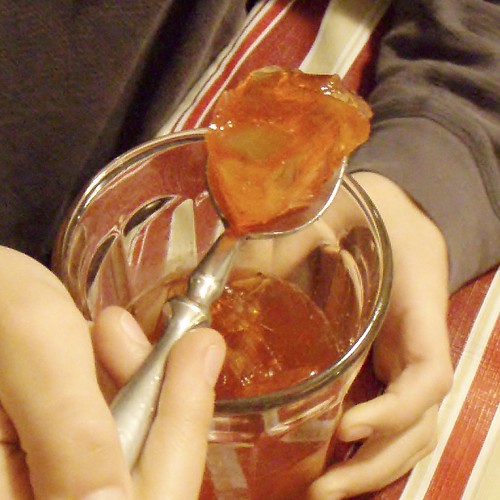
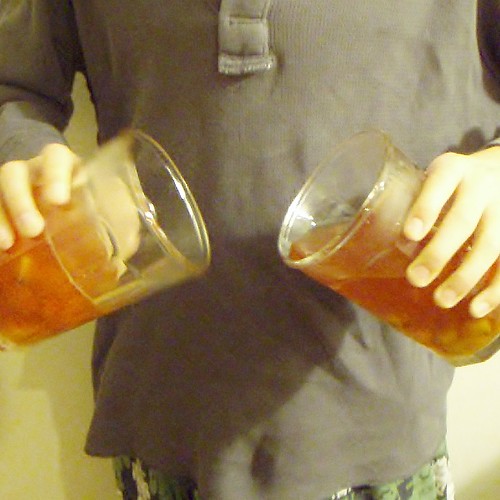




2 comments:
Pretty cool post.
I though you all might appreciate this as well: http://www.youtube.com/watch?v=I1sdN_v2Wbw
Post a Comment